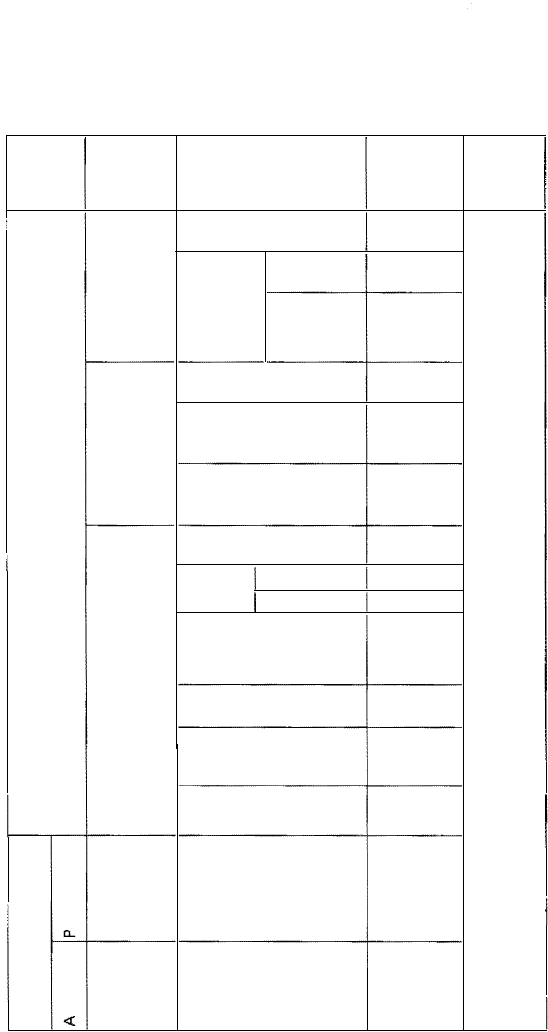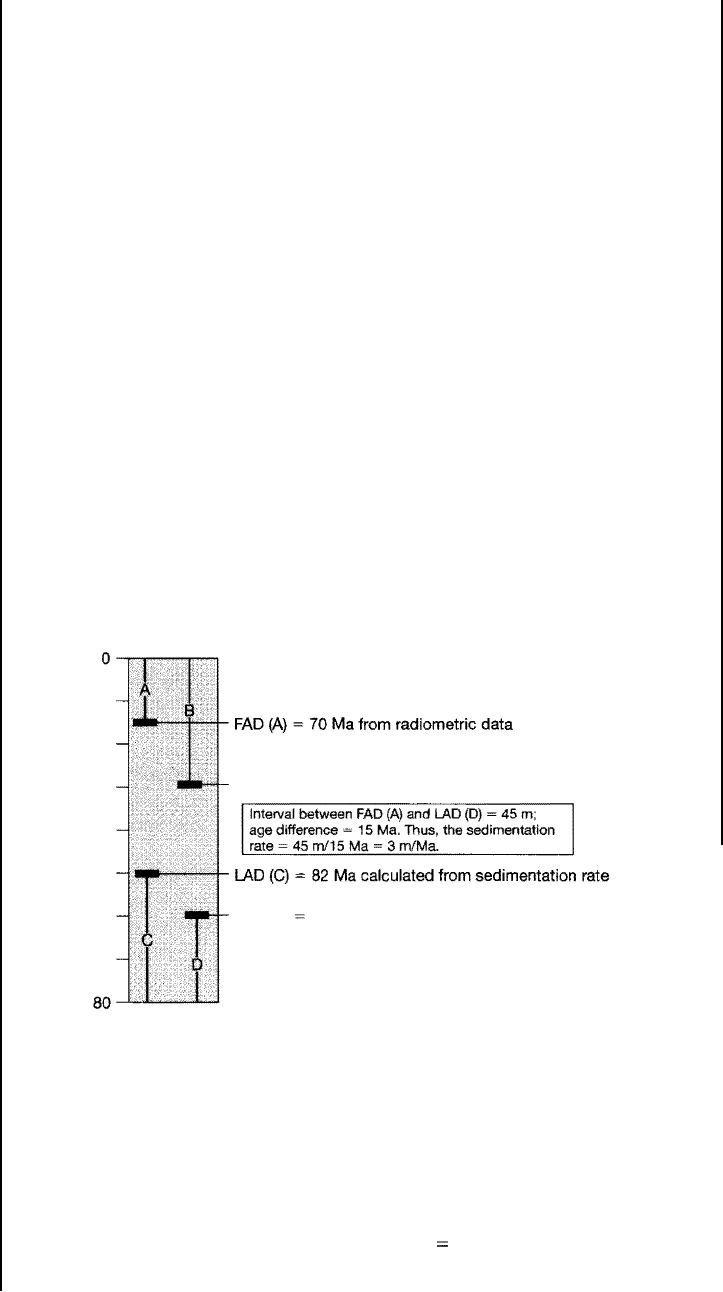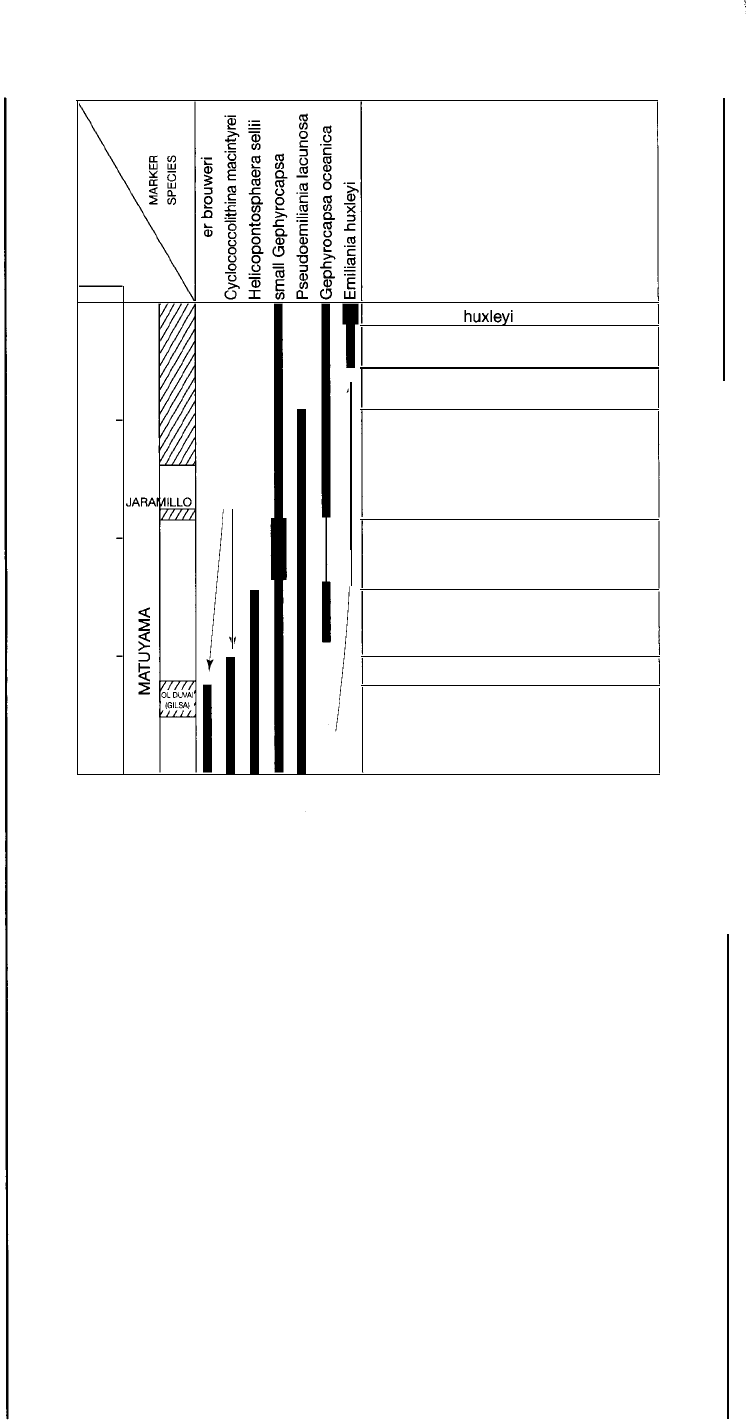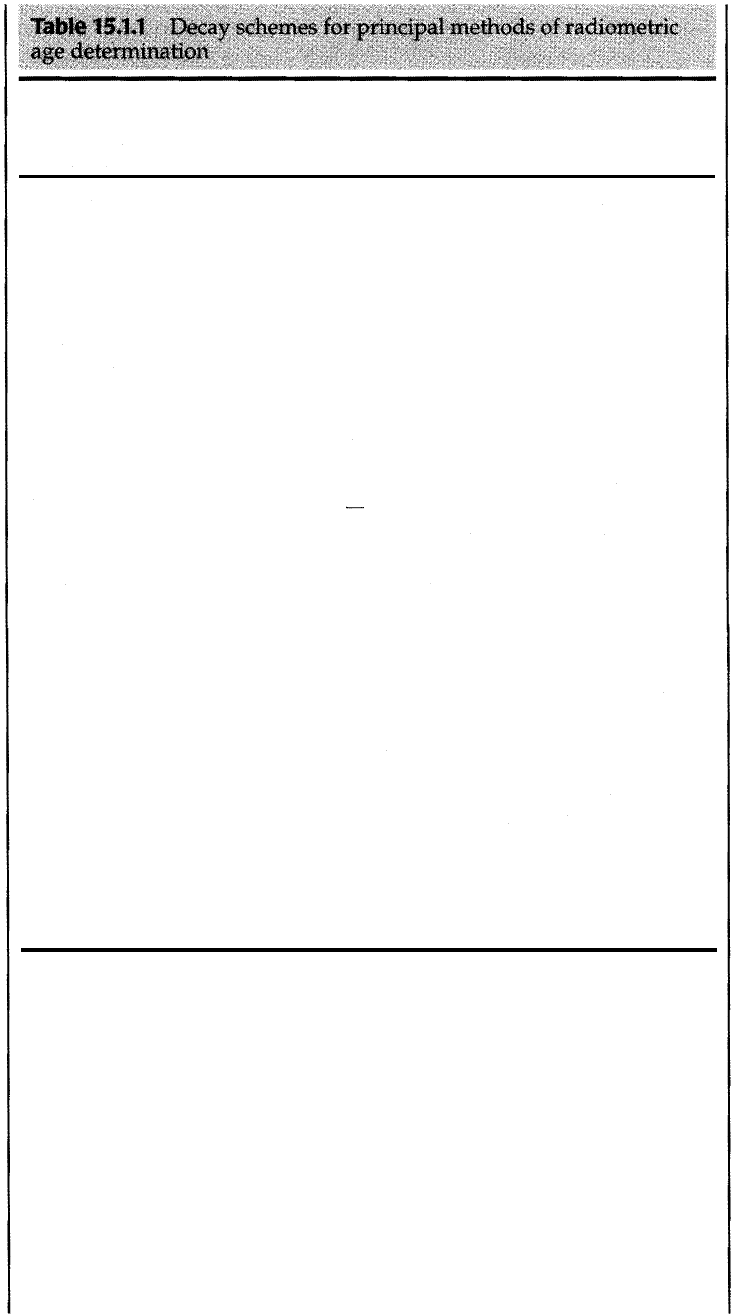Boggs S. Principles of Sedimentology and Stratigraphy
Подождите немного. Документ загружается.


15.2 Geologic Time Units
517
series, because series are rock its, not units of time. Most names for eons and eras
are the same as the names of the corresponding eonoems and erath ems.
Geochronometric units are pure time units. They are not based on the time
spans of designated chronostratigraphic stratotypes but are simply time divisions
of an appropriate magnitude or scale, with arbitrarily chosen boundaries. At this
time, a geochronometric time scale is used to express the ages of Precambrian
rocks (see Fig. 15.2) because no globally recognized and accepted chronostrati
graphic scale has been developed for these rocks. Precambrian rocks have not yet
proven generally susceptible to analysis and subdivision by superposition or by
application of other lithologic or biologic principles that we commonly use in sub
dividing the Phanerozoic rocks; however, a chronostratigraphic scale for Precam
brian rocks may be developed in the future. Subdivision of Precambrian rocks is
further discussed the next section.
Eonothem
Erath em
System and Subsystem
Series
Numerical
Age (Ma)
Quaternary
Holocene
0.1
Pleistocene
1.8
Pliocene
Cenozoic
Neogene
Miocene
23.8
Te rtiary
Oligocene
Paleogene
Eocene
Paleocene
65.0
Cretaceous
Upper
Lower
144.2
Upper
Mesozoic
Jurassic
Middle
Lower
206
0
Upper
5
Triassic
Middle
N
0 Lower
248
Upper
Permian
z
I
Lower
290
I
Carbon- I
Pennsylvanian
.
Upper
323
iferous
I
Mississippian
Lower
354
Upper
Devonian
Middle
Lower
Paleozoic
417
Silurian
Upper
Lower
443
Upper
Ordovician
Middle
Lower
490
Cambrian
Upper
Lower
543
0
Not
2
0
formally
z
subdivided
b
2500
z
0
Not
I
formally
.
0
subdivided
Source of ages: Geological Society of America 1999 Geologic Time Scale.
Figure 15.2
Nomenclature of Phanerozoic chronostratigraphic
units commonly used throughout the world. Pre
cambrian rocks are divided into the Archean and
Proterozoic; however, no scheme for further sub
division of the Precambrian is globally accepted.

518
Chapter 15 I Chronostratigraphy and Geologic Time
15.3 THE GEOLOGIC TIME SCALE
Purpose and Scope
Classifying rocks on the basis of time involves systematic organizaon of strata
into named units, each corresponding to specific intervals of geologic time. These
units provide a basis for time correlation and a reference system for recording and
systematizing specific events in the geologic history of Earth. Thus, the ultimate
aim of creating a standardized geologic time scale is to establish a hierarchy of
chronostratigraphic units of international scope that can serve as a standard refer
ence to which the ages of rocks everywhere the world can be related. Establish
g the relative ordering of events in Earth's history is the main contribution that
geology makes to our understanding of time.
A standard geologic time scale should express any age in any place, and it
should be understandable, clear, and unambiguous. It should also be independent
of opinion and therefore have some objective reference that is accessible. Finally, it
should be stable, that is, not subject to equent change, and it should be agreed to
and used inteationally in all languages (e.g., Harland, 1978).
Development of the Geologic Time Scale
Chronostratigraphic Scale
Geologists have been working for more than 200 years to develop a systematic
scheme for a global time-stratigraphic classification of rock units. This slow
process has evolved through two fundamental stages of development:
1. Determining time-stratigraphic relationships from local stratigraphic sections
by applying the principle of superposition, supplemented by fossil control
and, more recently, radiometric ages.
2. Using these local stratigraphic sections as a basis for establishing a composite
international chronostratigraphic scale, which serves as the material reference
for constructing a standardized international geologic time scale.
The international chronographic scale has evolved gradually over the past two
centuries into its present form (Table 15.1, Fig. 15.2). Figure 15.2 shows the hierar
chy of major chronostratigraphic units in general use throughout most of the
world. A more detailed chronostratigraphic scale that also shows subseries and
stages
is given in Appendix D; this chronostratigraphic and geochrohometric scale
was compiled by Salvador (1985) as part of the COSUNA (Correlation of Strati
graphic Units of North America) project. [Note: The ages of the boundaries be
tween chronostragraphic units shown in Appendix D may not agree with the
more recent age determinations given in the new geologic time scale shown in
Figure 15.3.] Some of the provincial stage names commonly used in North Ameri
ca are also shown in Appendix D; however, there now appears to be a general
movement among North American stratigraphers to abandon these provincial
stage names and adopt the European (global) stages as standards for North Amer
ica. Stratigraphers in Europe and many other parts of the world have for many
years subdivided the Tertiary into two subsystems, the Paleogene and the
Neogene, with the top of the Oligocene Series as the dividing boundary between
the two (Fig. 15.2). Geologists in North America have now also adopted this prac
tice. They have likewise adopted the European usage of the Carboniferous as a
system name, but with subdivision in North America into the Mississippian and
Pennsylvanian subsystems. Other versions of the chronostratigraphic scale exist
(e.g., Cowie and Basse
tt, 1989; Harland et al., 1990) that differ somewhat from

15.3 The Geologic Time Scale
519
1999 GEOLOGIC TIME SCALE
PA LEOZOIC
LTE
MIDD
•Jrternat1onal ages have not beer estab1ishecL These are regional (laurel"tian) only.
Sources for nomenclature ana ages: Primarily ftom Gradstel n, , and Ogg, j,, 1996, Ep isodes, v. 19, nos. i & 2: Gradstein, F. , al., 1995,
GEOLOGICAL SOCIE1Y
OF AMERICA
Figure 15.3
SEPM Special Pub. 95-128; Bergg ren, W. A., et at, 1995, SEPM Special Pub. 54, p, 129·212; Cambnan and basal OrdoViCian ages
adaed from Landing.
1
998, Canadian Joumai of Earth Scie nces, v. 35, p. 329-338; and Dav1dek, K, et al., 1998, Geological Magazme,
v. 135, p. 305-30R Cambrian age names from Pa!mer, A. R., 1998, Canadian Journal of Earth Sciences, v. 35, p. 323-328.
1999 geologic time scale published by Geological Society of America.
this scale, particularly in naming of series and stages and partial subdivision of
the Precambrian into erathems and systems. The geologic community has not yet
achieved the ideal of a truly international chronostratigraphic scale that is accept
ed and used by all geologists worldwide.
Geochronologic (Time) Scale
Figure 15.2 is a chronostratigraphic scale with units and boundaries based on
physical divisions of the rock record, but it is not in itself a time scale. To function
as a geologic time scale for expressing the age of a rock unit or a geologic event,
the chronostratigraphic scale must be converted to a geochronologic scale consist
ing of units that represent intervals of time rather than bodies of rock that formed
during a specified time interval. The geologic time scale is derived from the
chronostratigraphic scale by substituting for chronostratigraphic units the corre
sponding geochronologic uts (Table 15.1). Thus, the geologic time scale is ex
pressed in eras, periods, epochs, ages, and chrons rather than erathems, systems,
series, stages, and chronozones. The subdivision boundaries of the geologic time
scale
are calibrated in absolute ages; however, the geologic time scale differs from
900

520
Chapter 15 I Chronostratigraphy and Geologic Time
a true geochronometric scale, which is based purely on time without regard to the
rock record. By contrast, the subdivisions of the Phanerozoic time scale are of un
equal length, because they are based on chronostratigraphic units that were de
posited during unequal intervals of time.
The geologic time scale has been in existence for several decades, and during
that time it has continued to evolve, with refinements being made particularly in
subdivision of the epochs and ages and absolute-age calibration of the boundaries
between periods, epochs, and ages. Figure 15.3 shows the most recent version of
the geologic time scale published by the Geological Society of America in 1999.
This time scale is subdivided into ages based on the European stages, and bound
aries between ages are calibrated in absolute time. Absolute ages are given in mil
lions of years before the present (Ma), where the present refers to 1950. Methods
for absolute age calibration of the geologic time scale are discussed below. Note
that the magnetic polarity scale for the most recent approximately 160 million
years is also included in the time scale. Note also the use of a geochronometric
scale for the Precambrian, with the dividing boundary between the Archean and
the Proterozoic set arbitrarily at 2500 million years.
Box 15.1 Calibrating the Geologic Time Scale
As mentioned, the geologic time scale has evolved slowly over a long period
of time. To develop the scale to its present level of usefulness for fixing the po
sition in time of a particular rock unit or geologic event, two types of informa
tion had to be available to stratigraphers: (1) some method of arranging rocks
in an orderly succession on the basis of their relative position in time, or rela
tive ages, and (2) a method of determining the ages of the boundaries between
rock units on the basis of their absolute position in time with respect to some
fixed time horizon, for example, the present.
Placing strata in stratigraphic order in terms of their relative ages has
been the guiding principle used by stratigraphers in constructing the geologic
time scale. Relative ordering was determined by applying the principle of su
perposition, aided by use of fossils. The principle of superposition means sim
ply that in a normal succession of strata which have not been tectonically
overturned since deposition, the youngest strata are on top and the ages of the
strata increase with depth. Most of the divisions in the current global chronos
tratigraphic scale are based on fossils, and early efforts to create an inteational
chronostratigraphic scale before methods of absolute-age determinations were
developed would have been impossible without the use of fossils.
Fortunately, methods are now available not only for determining the rel
ative ages of strata but also for fixing within reasonable limits of uncertainty
the absolute ages of some strata. Development of these methods of absolute
age estimation have made it possible to place approximate absolute ages on
boundaries of the chronostratigraphic scale initially established by relative
age determination methods. Absolute age data can also be used for determin
ing ages of poorly fossiliferous Precambrian rocks that cannot be placed in
stratigraphic order by relative-age determination methods. The principal
method for determining the absolute ages of rocks is based on decay of ra
dioactive isotopes of elements in minerals. Other methods of determining the
absolute passage of geologic time include counting; lake-sediment varves,
which are presumed to represent annual sediment accumulations; growth in
crements in the shells of some invertebrate organisms; growth rings in trees;
and Milankovitch climate cycles in sediments. These alternative methods are

15.3 The Geologic Time Scale
521
useful only for marking the passage of short periods of time in local and re
gional areas and are not of importance in calibrating the geologic time scale,
except possibly some parts of the Pleistocene and Pliocene.
Thus, e major tools for finding ages of sedimen to calibrate the geolog
ic time scale are relative-age determinations by use of fossils-biochronology
and absolute age estimates based on isotopic decay-radiochronology. These
tools may be used both for calibrating the chronostratigraphic scale directly
and for calibrating the succession of reversals of Earth's magnetic field; this
succession constitutes e magnetostratigraphic time scale discussed in
Chapter 13. We shall now discuss each of these dating methods, beginning
with biochronology.
CALIBRATING THE GEOLOGIC TIME SCALE BY
USE OF FOSSILS: BIOCHRONOLOGY
Biochronology is the organization of geologic time according to the irre
versible
process of evolution in the organic continuum (Chapter 14). Useful
fossil horizons are more widespread and abundant in Phanerozoic rocks than
are horizons whose ages can be estimated by radiochronology. Furthermore,
biologic events can commonly be correlated in time more precisely than can
radiometric data in all but Cenozoic rocks. Because of these factors, fossils
have convenonally provided the most readily available tool for dating and
long-distance correlations of Phanerozoic rocks. It is necessary, however, to
make a clear distinction between biochronology and biostratigraphy. Bios
atigraphy (Chapter 14) aims simply at recognizing the disnctive fossils that
characterize a known stratigraphic level a sedimentary section without re
gard to the inherent time significance of the fossils. For example, William
Smith was able to use fossils very effectively for identifying and correlating
strata, even though he had little or no idea of the time relationships or time sig
nificance of the fossils. Biochronology, on the other hand, is concerned with
the recognition of fossils as having ages that fall at known points in the span of
evolutionary time, as measured by fossils of a reference biostratigraphic sec
tion. Therefore, by establishing identifiable horizons in reference sections
based on fossils, biochronology provides a tool both for international correla
tion and for worldwide age determination.
The aim of biochronology is to make possible correlation and dating of
the geologic record beyond the limits of local stratigraphic sections. To do this
most effectively, stratigraphers use features or events in the paleontologic
record that are widespread and easily identifiable and that occurred during
short periods of geologic time. These events are considered to be biochrono
logic datum events because they mark a particular short period of time in the
geologic past. The datum events most commonly used are the immigrations
(first appearances) and extinctions (last appearances) of a fossil species or
taxon. The first appearance of a species as a result of immigration from anoth
er area commonly occurs very rapidly after its initial appearance, owing to
evolution from its ancestral morphotype. The first appearance is so rapid, in
fact,
that geologically speaking we consider speciation and immigraon as es
sentially synchronous events. Extinction of a taxon may also occur very rapid
ly, although commonly not as rapidly as speciation.
Stragraphers speak of the first and last appearances of a taxon as the
rst appearance datum (FAD) and the last appearce datum (LAD). These
FADs and LADs are not totally schronous owing to e fact that even though
immigrations and extinctions can take place quite rapidly, as mentioned, they

522
Chapter 15 I Chronostratigraphy and Geologic Time
are not actually instantaneous events. Some planktonic species have been re
ported to spread worldwide in 100 to 1000 years; however, bioturbation of
sediment after deposition can mix fossils through a zone several centimeters
thick, and accidents in preservation as well as bias in collection and analytical
meods can combine to create uncertainties in the age of the FADs and LADs
that can amount to thousands of years. Nevertheless, the duration of the
FADs of many planktonic species may be as little as 10,000 years; that is, the
ages of the first appearance datum of a species will not vary by more than
10,000 years in different parts of the world (Berggren and Van Couvering,
1978). The error caused by an age discpancy of is magnitude becomes in
significant when applied to estimation of e ages of cks that are millions to
hundreds of millions of years old. Thus, the FADs and LADs of many fossil
species can be considered essentially synchronous for e utilitarian purposes
of biochronology.
FADs and LADs are the most easily utilized and communicated types of
fossil information upon which to base biochronology, and they can be used
across great distances within the range of the defining taxa. Therefore, ey
have come to domate global biochronological subdivision. The procedure
for establishing the biochronology of any fossil group based on FADs and
LADs involves the following steps (described by Haq and Worsley, 1982) and
is illustrated graphically in Figure 15.1.1:
1. Identify and locate in local biostratigraphic units e FADs and LADs of
distinctive fossil taxa at have wide geographic distribution.
20
g
40
c
0
.
60
Figure 15.1.1
FAD (B) = 75 Ma calculat from sedimentatio
n
rata
D (D)
85 Ma from radiometric data
Schematic illustration of the application of biochronology to age cal
ibration of a local stratigraphic section. The ages of the FAD for
Species A and the D for Species D are established by radiometric
dating of some closely associated physical feature (e.g., an ash bed).
The FAD for Species B and the D for Species C cannot be dated
radiometrically; however, the ages can be calculated from the sedi
mentation rate determined beeen FAD (A) and LAD (D). This rate
(3 m/Ma) can then be used to determine the age difference be
tween FAD (A) and FAD (B) ( 3 m/Ma x 15 m 5 Ma) and be
tween LAD (D) and D (C) (3 m/Ma x 10 m= 3 Ma).

15.3 e Geologic Time Scale
523
2. If possible, assi ages to these events by direct or indirect calibration
through radiochronology or magnetostratigraphy. If ages can be assigned
to any two events, the sedimentation rates for strata between these events
can be calculated by dividing the age difference between the o by the
thickness of sediment separating em. The sedimentation rates can then
be used to calculate e approximate age of each event enclosed within the
dated succession (Fig. 15.1.1).
3. If radiometric or magnetostratigraphic calibration of FADs or LADs in the
local section cannot be accomplished, then the ages of e datum levels
must be found in a different way. Under these conditions, ages of the
FADs and LADs are estimated on the basis of their stratigraphic position
with respect to calibrated datum levels of other fossil groups that also
occur in the sedimentary succession and whose ages have been found by
study of one or more successions elsewhere.
An example of biochronologic calibration is illustrated in Figure 15.1.2,
which shows the use of calcareous nannoplankton to establish a biochronol
ogy for the Pleistocene by direct correlation with magnetostratigraphic units.
CALIBRATING BY ABSOLUTE AGES: RADIOCHRONOLOGY
General Principles
Radiochronology is based on the principle that radiogenic minerals such as
uranium-235 and potassium-40 decay spontaneously at a fixed rate to a "daugh
ter" product. Thus, the age of a radiogenic mineral can be calculated from the
measured ratio of parent radionuclide to daughter product in the mineral, by
use of the known decay rate of the parent material. The decay rate is common
ly expssed as the half-life of the radioactive isotope (i.e., the time required
for one-half of the parent material to decay to the daughter product). The
number of atoms of the parent radioactive material and the inert daughter
product are measured by a mass spectrometer, which is an instrument that
separates and counts atoms of diffent masses or charges in a radiogenic min
eral such as zircon (Table 15.1.1).
The equation for calculating radiometric age is
t = -
+ 1
1
[D-Do
J
A
N
(15.1.1)
where N is the number of parent atoms of an element (e.g., uranium) present
in any given amount of the element, is log base e, D is the total number of
daughter atoms (e.g., lead), Do is the number of original daughter atoms, and
A is the decay constant, which is calculated from the relationship
(15.1.2)
where T1 ;2 is the half-life of the radioactive element (Faure, 1986, Chapter 4). N
and D are measurable; D0 is a constant whose value is either assumed or cal
culated from data for cognetic samples of the same age.
Radiometric Methods
incipal Methods. Some of the most useful radionuclides for estimating ab
solute ages and the minerals, rocks, and organic materials most suitable for

524
Chapter 15 I Chronostratigraphy and Geologic Time
MAGNETIC
STRATIGRAPHY
AGE
0.5
1.0
1.5
I
z
JARA �
Figure 15.1.2
0
u
J
0
Ds
\
I
NANNOFOSSIL
ZONES
Emiliania
huxleyi
Emiliania
huxleyi
Acme
Zone
Zone
Gephyrocapsa oceanica
Zone
Pseudoemiliania lacunosa Zone
small Gephyrocapsa Zone
Helicopontosphaera sellii Zone
Cyclococcolithina
macintyrei
Zone
t
FADs
Discoaster brouweri
Zone
An example of biochronological dating by use of nannofossil datum
events correlated with magnetic polarity events. [After Gartner, S., 1977,
Calcareous nannofossil biostratigraphy and revised zonation of the Pleis
tocene: Marine Micropaleontology, v. 2, Fig. 5, reprinted by permission
of Elsevier Science Publishers.]
age determination are shown in Table 15.1.1. The carbon-14 method is applied
to direct dating of very young sediments. The protactinium-231 and thorium-
230 methods are also applied to direct dating of sediments ranging in age to
about 250,000 years. The usefulness and limitations of these methods for direct
dating of sediments are discussed further in succeeding sections.
Most radiometric dating methods cannot be applied to direct dating of
sedimentary rocks. They are used to determine the ages of igneous and meta
morphic rocks, which indirectly provide ages for associated sedimentary rocks
(to be discussed). The potassium/argon method is widely used because it can
be applied to a number of minerals that are common in igneous and metamor
phic rocks, and it gives generally reliable results. It can be used for dating plu
tonic, igneous, volcanic, and metamorphic rocks (metamorphism resets the
radioactive clock), and even some sedimentary minerals (e.g., glauconite). The
principal problem with the potassium/ argon methods is that the decay prod
uct, argon-40, is a gas that can leak out of a crystal.
The argon-40/argon-39 method is a related technique in which potassi
um-39 is converted to argon-39 by irradiation with fast neutrons in a nuclear

Approximate
useful
Parent
Daughter
Half-life
dating range
nuclide
nuclide
(years) (years B.P.)
Carbon-14
*Nitrogen-14
5730
**
<�40,000
Protactinium
*Actinium-227
32,480
<�150,000
-231 (daughter
nuclide of
uranium-235)
Thorium-230
*Radium-226
75,200
<�250,000
(daughter nuclide
of uranium 238/234)
Uranium-238 Lead-206
4500
10->4500
million
million
Uranium-238
Spontaneous
**
<�65
fission tracks
million
Uranium-235
Lead-207
710
10->4500
million
million
Potassium-40
Argon-40
1250
1->4500
million million
Rubidium-87
Strontium-87
48 billion
10->4500
million
Samarium-147
Neodymium
106
> 200 million
-143
billion
Lutetium-176
Hafnium-176
35 billion
> 200 million
Half-life data om Bowen (1998).
*Not used calculang radiomeic ages.
*an be used for dating older rocks under favorable circumstances.
15.3 e Geologic Time Scale
525
Materials
commonly
used for
dating
Wo od, charcoal,
CaC0
3
shells
Deep-sea sediment,
aragonite corals
Deep-sea sediment,
aragonite corals
Zircon
,
monazite, sphene,
uranium/thorium
minerals
Volcanic glass,
zircon, apatite,
sphene, gaet
Zircon, monazite,
sphene, uranium/
thorium minerals
Muscovite, biotite,
feldspars,
glauconite, whole
volcanic rock
Micas, K-feldspar,
whole metamorphic
rock
,
glauconite
Pyroxene,
plagioclase, garnet,
apatite, sphene
Pyroxene,
plagioclase, garnet,
apatite, sphene
reactor. The ratio of potassium-39 to potassium-40 is known, so argon-39 can
serve as a proxy for potassium-40. This relationship permits the potassium de
termination for a potassium-argon age to be made as
part of the argon isotope
analysis. In other words, measurement of the amount of argon-39 (which prox
ies for potassium-40) renders it unnecessary to separate potassium from a min
eral and measure e amount of potassium-40. Both argon-39 and argon-40 are
measured during the argon analysis. age can be determined from the
argon-40/ argon-39 ratio once the conversion rate of argon-40 to argon-39 has
been determined by irradiating a standard of known age along with the

526
Chapter 15 I Chronostratigraphy and Geologic Time
sample (e.g., Bowen, 1998). The method is so sensitive that very small sam
ples can be used, and it has the further advantage that it allows correction
for loss of argon by leakage. Because of these advantages, it is being in
creasingly used.
Like the potassium/ argon method, the rubidium/strontium method can
also be applied to a number of common minerals; however, it is less common
ly used. Rubidium is so rare that a long decay period is required to generate a
measurable amount of strontium. The uranium/lead methods make use of
minerals such as zircon, sphene, and monazite as well as some less common
uranium/thorium minerals. These methods give generally reliable ages for
older rocks and can be used for dating some rocks as young as about 10 million
years.
Fission-track dating is a technique that relies on counting fission tracks
in minerals such as zircon (e.g., Waer and Van den Haute, 1992). Emission of
charged particles from decaying nuclei causes disruption of crystal lattices, cre
ating the tracks, which can be seen and counted under a microscope. The older
the mineral the more tracks are present. The samarium/neodymium and
lutetium/hafnium methods are less commonly used dating techques that
may be applied to some rocks that are less amenable to dating by convention
al methods. Samarium and lutetium are rare earth elements with long half
lives, making them useful for dating very old (Precambrian) rocks.
Additional, specialized dating methods (e.g., amino-acid racemization
method, obsidian hydration method) are available also (Faure, 1986; Geyh and
Schleicher, 1990). Details of radiochronologic methods and discussions of er
rors and uncertainties in radiometric age determinations are available in sev
eral published volumes (e.g., Bowen, 1988, 1998; Dickin, 1995; Easterbrook,
1988; Faure, 1986; Geyh and Schleicher, 1990; Mahoney, 1984; McDougall and
Harrison, 1988; Odin, 1982; Parrish and Roddick, 1985; Williams, Lerche, and
Full, 1988).
Application to Dating Sedimentary Rocks. Although radiochronologic
methods can be applied to a variety of rock materials and organic substances
(Table 15.1.1), they have limited application to the direct estimation of ages of
sedimentary rocks. Most of the potentially usable minerals in sedimentary
rocks are terrigenous minerals that when analyzed yield the age of the parent
source rock (see Appendix B), not the time of deposition of the sedimentary
rock, although a few mare minerals such as glauconite can be used for direct
dating of sedimentary rocks. Therefore, much of the geologic time scale has
been calibrated by indirect methods of estimating ages of sedimentary rocks
on the basis of their relationship to igneous or metamorphic rocks whose ages
can be determined by radiochronology. The types of rocks that are most useful
for isotopic calibration of the geologic time scale are described in Table 15.1.2.
We will now examine in greater detail the most common methods used to find
ages of the sedimentary rocks of the international chronostratigraphic scale.
These methods are not, of course, restricted to determining the ages of sedi
mentary rocks that make up the inteational chronostratigraphic scale. They
can be applied to determining the ages of sedimentary rocks in generaL
Finding Ages of Sedimentary Roc by alysis of Interbedded "Contem
poraneous" Volcanic Roc. Lava flows and pyroclastic deposits such as ash
falls can be incorporated very quickly into an accumulating sedimentary succes
sion without significantly interrupting the sedimentation process. Volcac mate
rials may be erupted onto "soft" unconsolidated sediment and then buried
during subsequent, continued sedimentaon, leading to a succession of interbed
ded sedimentary rocks and volcanic rocks that are essentially contemporaneous
